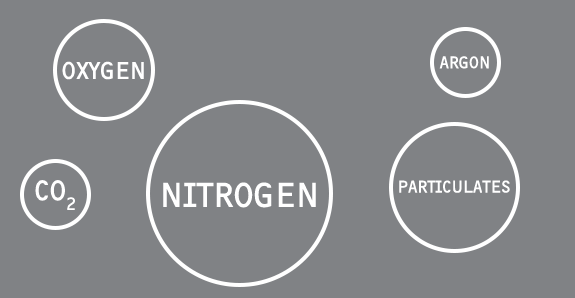Air Quality and Filtration

Air pollution is one of the most serious issues facing the world. Air pollution, particularly from human activity, can affect our health — from lung problems to long-term problems such as cancer. A passive house with high levels of airtightness along with ventilation and fine filtration is well placed to combat this problem.
What is air made up of?
In addition to oxygen, the air you breathe is composed of many other things. Around 21 per cent of air is made up of oxygen. Approximately 78 per cent of the air you breathe is a gas called nitrogen. The remaining portion is made up of other gases such as argon, carbon dioxide and methane.

What affects air quality?
Vehicle emissions
One of the significant sources of air pollution in Australia is cars and trucks. Several vehicle air pollutants can impact health and cause smog.
Burning of fossil fuels
Besides being non-renewable forms of energy, the burning of oil, coal, and gas, produces large quantities of carbon dioxide.
Other pollutants
Other forms of pollution include exhaust from industrial and manufacturing plants, construction and farming and natural hazards such as bushfires, volcanoes and dust storms.
Bush fires, air quality and air filtration
The 2019/20 bushfires have affected the air quality of Australian towns and neighbouring countries. Poor air quality caused by smoke poses a risk to otherwise healthy people. Bushfire smoke can travel hundreds of kilometres and has negatively altered the air quality in Canberra, Sydney, Melbourne, Adelaide, Launceston as well as New Zealand and Chile.
Particulates and Air Quality
PM stands for particulate matter: the term for a mixture of airborne solid particles and liquid droplets. Many particles are large or dark enough to be seen with the naked eye, such as dust, dirt, soot, or smoke. Others are so small that only an electron microscope can detect them.
PM10
Inhalable particles. 10 micrometres in diameter and smaller.
PM2.5
Fine inhalable particles, 2.5 micrometres in diameter and smaller.
PM1
Fine inhalable particles, 1 micrometres in diameter and smaller.
Particulate matter can be inhaled and can lead to severe health problems. Some particles less than 10 micrometres in diameter can permeate the lungs, and some may even get into the bloodstream. Of these, particles less than 2.5 micrometres in diameter, also known as fine particles or PM2.5, pose the greatest risk to health.
Air Quality Index (AQI)
The Air Quality Index (AQI) provides an easy-to-understand index measuring pollution levels in various regions around the world. The AQI monitoring sites display a range of colours relevant to the air quality measured. Some people may be more vulnerable to air pollution. Sensitive groups include older adults, pregnant women, people with heart and lung problems and children.
| Air Quality Index (AQI) | Colour indicator | Description |
|---|---|---|
| 0 – 33 | Very good | Enjoy normal activities. |
| 34 – 66 | Good | Enjoy normal activities. |
| 67 – 99 | Fair | People unusually sensitive to air pollution should reduce or reschedule strenuous outdoor activities. Others are not likely to be affected when the AQI is in this range. |
| 100 – 149 | Poor | Sensitive groups should reduce or reschedule strenuous outdoor activities. Other adults are not likely to be affected when the AQI is in this range. |
| 150 – 199 | Very poor | Sensitive groups should avoid strenuous outdoor activities. Other adults should reduce or reschedule strenuous outdoor activities. |
| 200+ | Hazardous | Sensitive groups should avoid all outdoor activities. Other adults should avoid strenuous outdoor activities. |
Real Time Air Quality Index
The below tool displays real-time air quality data for Australia, including ACT, Sydney and Melbourne. Air quality data for the rest of the world is also displayed. Zoom in further to the map to see more detail for a particular area.
Filter Classification – EN779 & ISO 16890
Under the ISO standard, filters for ventilation are divided into four groups: PM1, PM2.5 and PM10 and PM coarse. The prerequisite for each category is that the filters capture at least 50 per cent of the appropriate particle size. For example, if a filter captures more than 50% of PM1 particles, it is classified as an ISO ePM1 filter. The respective efficiencies are then reported, rounded by 5% increments.
The ISO 16890 standard replaces EN779 and is the new global standard for testing and classification of air filters. The two standards do not directly translate as they use very different measurement and assessment methods.
Comparing both standards, the fine filter for the VLR 70 S achieves an ePM1 ≥ 50 % rating according to ISO16890. This filter was rated F7, according to EN779. The VLR course filter, known as a G2 under EN779, has been rated ISO Coarse > 30 % in the new standard.
The new ISO 16890 standard facilitates one global standard and offers more rigorous testing, down to 0.3 microns.
| Filter Group | Particulate Size (µm) | Classification Criterium *ePM = efficiency Particulate Matter |
|---|---|---|
| ISO ePM1 | 0.3 ≤ x ≤ 1 | Minimum efficiency ≥ 50 % |
| ISO ePM2.5 | 0.3 ≤ x ≤ 2.5 | Minimum efficiency ≥ 50 % |
| ISO ePM10 | 0.3 ≤ x ≤ 10 | Average efficiency ≥ 50 % |
| ISO Coarse | 0.3 ≤ x ≤ 10 | Average efficiency < 50 % |